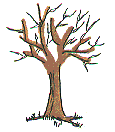National Wildlife Federation
Certifies Local Backyard
as Official Wildlife Habitat

NATIONAL WILDLIFE FEDERATION
WASHINGTON--The word is out on the grapevine that Abbie Slaman, Dumont, NJ has put out the welcome mat for all kind of birds, butterflies, and other wildlife, while helping to protect the local environment. The Slaman property is now recognized as National Wildlife Federation (NWF) Backyard Wildlife Habitat #30121.
Joining over 28,000 property owners in the U.S. and Canada, Mrs. Slaman is providing habitat by cultivating trees, shrubs, and flowers that offer food and cover for wildlife, thus attracting butterflies, birds, frogs, and small mammals. This effort promotes common-sense conservation by reducing or eliminating the need for fertilizers, pesticides or irrigation water.
The Backyard Wildlife Habitat program offers individuals, families, and organizations an easy and enjoyable introduction to nature that can yield a lifelong commitment to conservation. It is one of many NWF efforts to educate, inspire and assist people in protecting wildlife and the environment.
Since the program began in 1973, Backyard Wildlife Habitats have sprouted in urban, suburban, and rural sites everywhere, from post offices, schools, and places of worship, to hospitals, community parks, and municipal facilities. The majority can be found at residential properties like the Slaman yard.
Easy step-by-step instructions on how to create a Backyard Wildlife Habitat may be obtained by calling (703)438-6100, by writing to NWF, 11100 Wildlife Center Drive, Reston, VA 20190 or by visiting www.nwf.org.
Backyard Wildlife Habitat information packets are also available at all 200-plus Wild Birds Unlimited stores in the U.S. and Canada. The Backyard Bird Feeding Specialists at Wild Birds Unlimited can help property owners meet the qualifications to certify their property as an official National Wildlife Federation Backyard Wildlife Habitat.
The nation's largest member-supported conservation group, the National Wildlife Federation unites people from all walks of life to protect nature, wildlife, and the world we all share. NWF has educated and inspired families to uphold America's conservation tradition since 1936.

Sunflowers, pumpkin vine and nasturtium grew on the south side of the lattice. |
A few native perennials and stepping stones are added every year, gradually eliminating the need to mow the west side of the house. |
|
Abbie's favorite rosa rugosa Alba was added late in the summer of 2001 -- lovely white single flowers and bittersweet-colored hips. |
